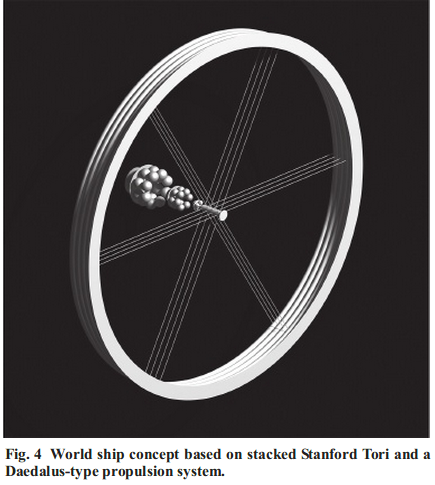The TV show Ascension has a plot that a Project Orion style interstellar generation ship was launched in 1963.
Ignoring the challenge of needing many times the number of nuclear bombs that were ever made for an Interstellar project Orion there are other issues.
We have not solved a space portable sustainable artificial ecosystem. Icarus Interstellar has Project Persephone now. It is the research is looking at how a long-duration manned mission out of the solar system could feasibly survive. Any future ‘generation ship’ we build will need to be entirely self-sustainable in terms of not only food and water, but cultural advances as well. In essence, any manned vehicle we one day send into interstellar space will need a ‘flourishing ecosystem’.
Project Persephone aims to develop a design approach for a worldship to underpin truly ecological architectural practices, in which matter can be attributed with agency. This requires us to think much more broadly about the performance and innate creativity of the materials we use.
Specifically Project Persephone’s aims are to:
Establish the parameters in the design and construction of a living interior to a worldship.
Build international multidisciplinary partnerships between academia and industry as a hub of research and development.
Develop designs, prototypes and models to propose solutions.
Apply innovations to real-world urban contexts to address current challenges of resource constraints, biodiversity and design of urban ecologies.
Explore new technologies in developing architectural prototypes.
Establish possible new paradigms for urban development that are successful within resource constrained environments
Project Hyperion is the Interstellar Worldship project.
World Ships – Architectures and Feasibility Revisited
A world ship is a huge self-sufficient and self-contained manned interstellar spacecraft. According to Martin, it carries hundreds of thousands of people and travels between the stars with a fraction of the speed of light. The world ship is probably one of th eoldest concepts for manned interstellar flight. Martin gives a concise overview of past world ship concepts, dating back to J.D.Bernal in the 1920. In 1984, Bond and Martin published the up-to-date most comprehensive engineering feasibility assessment of a world ship. They focused on mission duration, governed by the distance between stars, mission architectures, habitat de-sign, and propulsion. Other world or colony ship publications focused on propulsion systems, e.g. solar sails, ramjets, fusion propulsion. Grant assessed world ship feasibility based on reliability strategies.
Project Hyperion is working on the first ever design of a manned interstellar vessel. Recently, the team thought about how to leverage on existing heritage for the spacecraft’s subsystems. In particular, two major elements of a crewed spacecraft were of particular interest: the propulsion system and the habitat. A preliminary analysis has already been done by the team about two years ago.
Options for the propulsion system included Daedalus, Project Icarus’ Ghost Ship, as well as laser sails. For the habitat, various O’Neill colony designs, the Stanford Torus, as well as the 1976 MIT space colony design and the National Space Society’s Kalpana One colony were considered. Based on these criteria, the current Project Icarus, Ghost Team’s design was chosen for the propulsion system and the Stanford Torus design for the habitat. The Stanford Torus is the result of a 1975 NASA Summer Study, conducted under participation of such illustrious personalities as Gerard O’Neill and Eric Drexler. The Torus has the capability to sustain the lives of 10,000 to 14,000 inhabitants. This number is in accordance with the recent results obtained by Cameron Smith for the minimum size of a generation ship’s population. However, in order to make the habitat “interstellar-ready”, various modifications are necessary:
– The colony cannot be illuminated by Sunlight and has to be modified to an internal light source
– Radiation shielding has to be modified in order to shield against the increased galactic cosmic rays (GCRs) in interstellar space; extremely energetic particles, which have their origin in violent cosmic events, such as supernovae
– Shielding against interstellar matter has to be provided
– An internal power source is needed, as Sunlight is not available in interstellar space
SOURCES – Icarus Interstellar, University of Greenwich, Daily Mail UK, Syfy

Brian Wang is a Futurist Thought Leader and a popular Science blogger with 1 million readers per month. His blog Nextbigfuture.com is ranked #1 Science News Blog. It covers many disruptive technology and trends including Space, Robotics, Artificial Intelligence, Medicine, Anti-aging Biotechnology, and Nanotechnology.
Known for identifying cutting edge technologies, he is currently a Co-Founder of a startup and fundraiser for high potential early-stage companies. He is the Head of Research for Allocations for deep technology investments and an Angel Investor at Space Angels.
A frequent speaker at corporations, he has been a TEDx speaker, a Singularity University speaker and guest at numerous interviews for radio and podcasts. He is open to public speaking and advising engagements.



